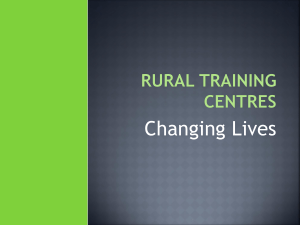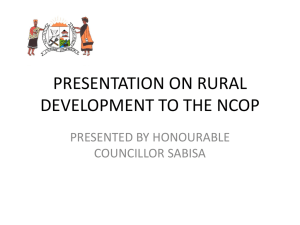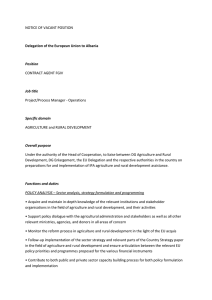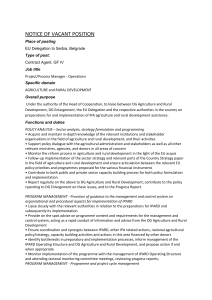Increasing access to health workers in remote and
advertisement
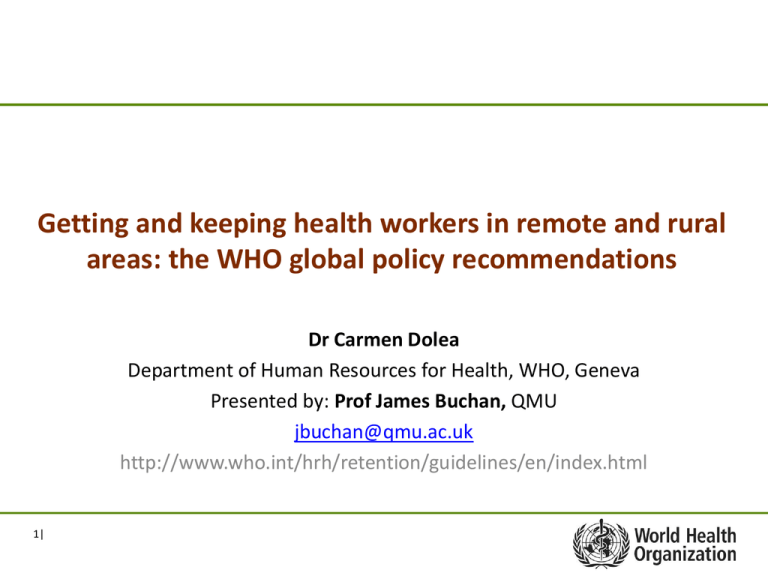
Getting and keeping health workers in remote and rural areas: the WHO global policy recommendations Dr Carmen Dolea Department of Human Resources for Health, WHO, Geneva Presented by: Prof James Buchan, QMU jbuchan@qmu.ac.uk http://www.who.int/hrh/retention/guidelines/en/index.html 1| Overview – developing the WHO recommendations • Why “guidelines”? • How did we go about it? • What are the WHO recommendations? 2| Why “guidelines” for rural retention • "Recommendation/guideline" implies a course of action needs to be taken AND that progress can be measured against a set baseline • "Policy options" are good, but may remain "optional", not "actioned upon" • Systematic, explicit and transparent process of evidence gathering/assessment and of formulating the recommendations 3| How did we go about it 4| Access to health workers in remote and rural areas depends on two inter-related aspects 5| Factors influencing decisions to stay in or leave rural and remote areas • Personal – Rural background (origin), values, altruism • Family and community – Provision of schooling for children, sense of community spirit, community facilities available • Financial aspects – Benefits, allowances, salaries, payment system • Career related – Access to continuing education opportunities, supervision, professional development courses/ workshops etc, senior posts in rural areas • Working and living conditions – Infrastructure, working environment, access to technology/medicines, housing conditions etc • Bonding or mandatory service: – Whether obligated to serve there Source: WHO 2010 6| 6 The 16 WHO global policy recommendations Category of intervention Examples A1 Students from rural backgrounds A2 Health professional schools outside of major cities A. Education A3 Clinical rotations in rural areas during studies A4 Curricula that reflect rural health issues A5 Continuous professional development for rural health workers B1 Enhanced scope of practice B. Regulatory B2 Different types of health workers B3 Compulsory service B4 Subsidized education for return of service C. Financial incentives C1 Appropriate financial incentives D1 Better living conditions D2 Safe and supportive working environment D. Professional and personal support 7| D3 Outreach support D4 Career development programmes D5 Professional networks D6 Public recognition measures Education interventions: the “rural pipeline” Support of rural HCWs: nurturing the RIGHT ENVIRONMENT Career ladders for rural health workers (South Africa) Postgraduate training: creating the RIGHT OPPORTUNITIES Rural residency programmes (Sudan, Australia, Canada) Undergraduate training: getting the RIGHT CONTEXT create schools outside major cities (Mali, Canada) rural clinical placements in rural areas (Australia) changes in curricula (South Africa) Student selection: choosing the RIGHT PEOPLE targeting admission of students from a rural background (Sudan; Thailand) 8| Regulatory interventions: different types of health workers or different types of contracts • Compulsory service: not always effective, requires reinforcement and heavy administration • Enhancing the scope of practice for rural health workers: more duties and responsibilities, not always accompanied with adequate rewards • Different types of health workers: clinical officers a potential solution 9| Financial incentives: how much is "large enough"? 10| Professional and personal support: most likely to work, yet very little done for it – Living and working conditions – Professional networks, journals etc – Outreach support/telemedicine – Career ladders for rural health workers – Titles, awards, public recognition 11| Retention strategies – from planning to implementation, monitoring and evaluation Situation analysis Choosing the interventions: what criteria? Monitoring and evaluation 12| • Identify health service needs • Labour market analysis • Understanding preferences and health workers needs • Effectiveness: does it work? • Relevance: time to impact, enforcement capacity, regulatory framework, urban underemployment • Acceptability: stakeholders engagement • Affordability: sources of funds, sustainability • Complementarities with other interventions • • • • Plan for it from the beginning Indicators: outcomes of interest , impact Methods and tools: capacity of health information systems Roles of stakeholders and partners Roadmap and tools for implementation Monitoring and evaluation: WHO framework: design, process, Indicators, outcomes of interest Implementation: Human resources management systems Performance appraisal system, including awards Source: Draft WHO/CapacityPlus/WB roadmap to support implementation of rural retention strategies 13| Understanding the problem: Scope of the problem Factors affecting decisions of location Preferences and choices (DCE) Labour market survey Choosing the interventions: Effectiveness Relevance: time to impact, enforcement capacity, urban underemployment Acceptability: stakeholder analysis Affordability: costing tool Complementarities Choosing the most appropriate interventions • Decisions often driven by everything else but evidence • However, some essential criteria need to be considered before selecting a package: – Effectiveness – Relevance: • Time to impact • Enforcement capacity • Urban underemployment – Acceptability – Affordability – Complementarities 14| Time to impact Category of intervention SHORT-TERM MEDIUM-TERM (or timeframe difficult to determine) A5. Continuous professional development for rural health workers A3. Clinical rotations in rural areas during studies B1. Enhanced scope of practice (task-shifting) B3. Compulsory service B4. Subsidized education for return of service B2. Different types of health workers (midlevel cadres) EDUCATION REGULATORY FINANCIAL INCENTIVES PROFESSIONAL AND PERSONAL SUPPORT 15| LONG-TERM A1. Student from rural background A2. Health professional schools outside the major cities A4. Curricula that reflect rural health issues C1. Appropriate financial incentives D2. Safe and supportive working environment D5. Professional networks D6. Public recognition measures D1. Better living conditions D3. Outreach support D4. Career development programmes Source: Draft WHO/CapacityPlus/WB roadmap to support implementation of rural retention strategies Monitoring and evaluation: a framework for measuring results Number of students from rural background reporting their intention to practice in rural/remote/underserved area Number of students from rural background selected/recruited into medical or health professional schools Number of students from rural background retained in rural/remote/underserved area Source, WHO, 2010 16| A complex issue in a complex environment Ministry of Finance Development partners World Bank Education and regulatory interventions Ministry of Labour WHO GAVI Ministry of Health The Global Fund PEPFAR Ministry of Higher Education Direct and indirect financial incentives Management, environment and social support Civil Service Commission Ministry of Transport 17| Ministry of Public Administration Health workers Professional Associations Populations/ Communities Thank you for your attention! For further information, please contact Dr Carmen Dolea: doleac@who.int http://www.who.int/hrh/retention/guidelines/en/index.html 18|

